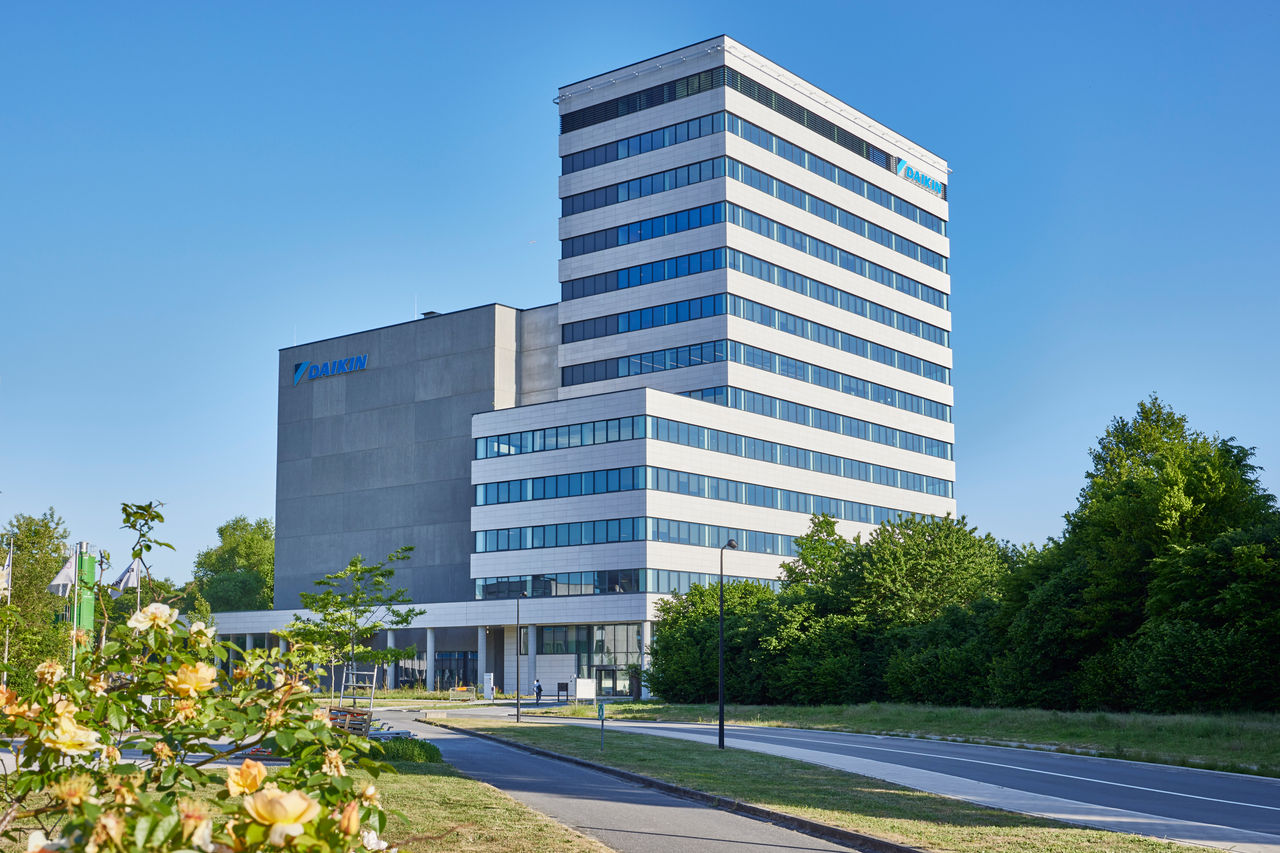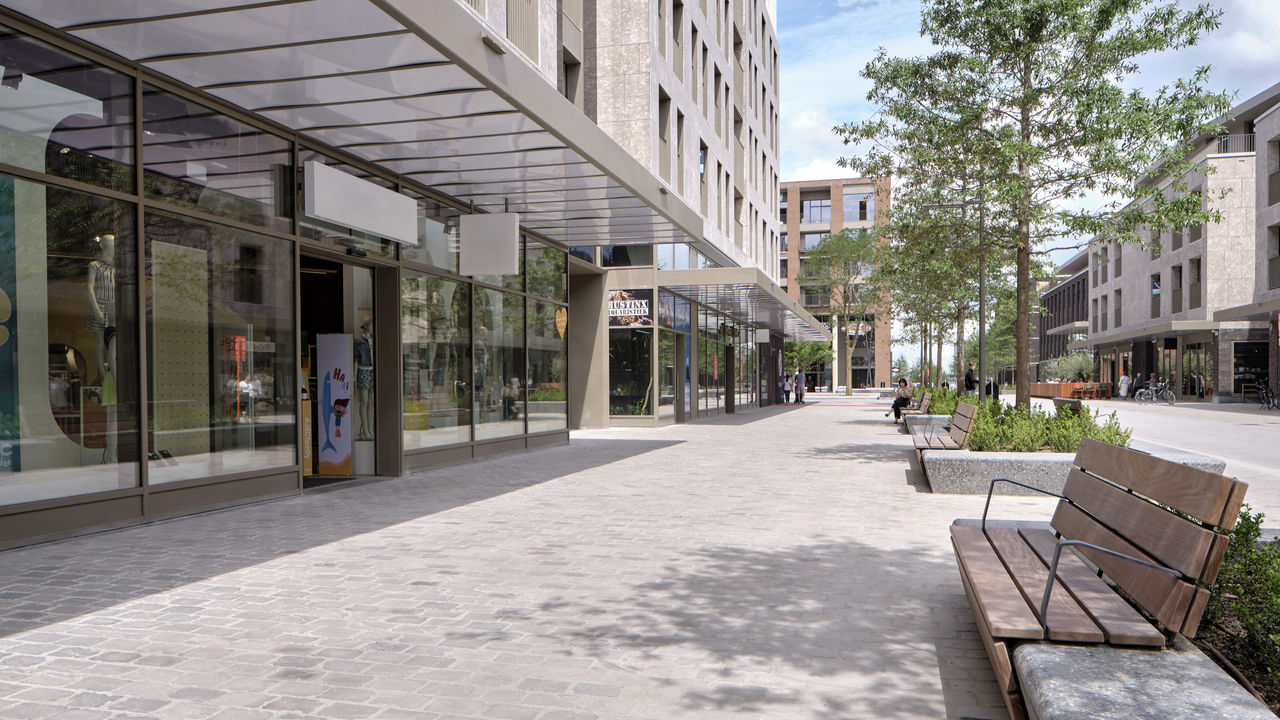
Given the gigantic dimensions of the Engelbert Strauss CI Factory, it’s important to keep a cool head. Newly built between 2017 and 2019, the production site of the well-known manufacturer of work clothes, footwear and accessories in Schlüchtern/near Frankfurt am Main, has factory space of 90,000m2, with almost 55,000m2 of it needing to be air conditioned. That is the equivalent of almost eight football fields. Five Daikin chillers with a total rated output of 3,450 kW were installed in order to meet the client's requirements for climatic comfort and to ensure the most energy-efficient operation of the building services. These operate using the new, climate-friendly refrigerant R1234ze, which has an especially low greenhouse potential (GWP value of 7).
The new Engelbert Strauss CI Factory in Schlüchtern can be seen in the distance from the A66 motorway near Schlüchtern (Main-Kinzig district). A gigantic industrial steel building dominates the landscape with a glass facade that was at one time the largest facade construction project in Germany. At 22,500 m², it is larger than the glass facade of Hamburg's Elbphilharmonie. The high-bay warehouses alone rise up 17 metres. The modern construction project for Engelbert Strauss involved an investment in the three-digit million range. Construction of its more than 90,000 m² of factory space started with the ceremonial ground-breaking in September 2017 and was completed at the end of 2019. The CI Factory, built in accordance with Energy Saving Ordinance EnEV 2014/2017, is the new state-of-the-art production site of the family-owned company founded in 1948. It is now in its fourth generation of manufacturing work clothes and footwear for commercial customers from the manual trades, industry and service sectors in more than 30 countries. Some 350 new jobs had been created there by the end of 2020.

The CI Factory is the new state-of-the-art production site of the family-owned company founded in 1948. It is now in its fourth generation of manufacturing work clothes and footwear for commercial customers from the manual trades, industry and service sectors in more than 30 countries. Some 350 new jobs had been created there by the end of 2020. © DAIKIN
Personalised work clothes
Employing state-of-the-art logistics, Engelbert Strauss creates completely new possibilities for the individualisation of work clothes with its CI Factory. It is possible to assemble individual and branded company shoes from a wide range of components, thanks to innovative, automated manufacturing technology combined with robot-assisted shuttle logistics. Fully automatic shuttles transport products along a total of 13 kilometres of conveyors through a variety of production areas, from goods receipt to direct dispatch or further internal processing. Up to 4,000 items per hour can be processed during peak periods. A special highlight of the CI Factory is a glass-enclosed shoe plant that produces more than 400,000 individual shoes per year.
Maximum environmental compatibility
Engelbert Strauss not only set the highest standards for innovation in the individualisation of its products, but also in the planning of the CI Factory in terms of its climate and environmental friendliness. On the roof of the logistics centre, for example, there is a photovoltaic array with a nominal output of 800 kWp, which corresponds to the energy needs of 200 households. The cooling and air conditioning of the building project therefore also had to be planned and implemented entirely in accordance with this credo. Together with system manufacturer STAR Kälte-Service GmbH from Bruchköbel, Engelbert Strauss opted for Daikin chillers. “We’ve been a specialist partner of Daikin for many years. They offer good products in the cold water and VRV sector and have developed a close working relationship with us. The high quality of their systems, combined with the reliability and expertise of Daikin staff are two of the many reasons why we decided to work with Daikin as a partner on this project,” says Burkhard Taus, Managing Director of STAR Kälte GmbH.

At 22,500 m², the gigantic industrial steel building with a glass facade was and is the largest facade construction project in Germany. It is larger than the glass facade of Hamburg's Elbphilharmonie. © DAIKIN
Close cooperation between all trades
Early on in this new-build project, a group of tradesmen came together to coordinate and plan the HVAC trades. During the entire construction period, the group supervised the construction management and implementation of the technical building equipment together with the electrical tradespeople, the building owners, the concrete workers and the responsible engineering office. “This allowed many problems and complications to be solved in the shortest possible time,” Burkhard Taus enthuses. “This close collaboration between all the trades made for a super construction process that was able to meet all the set schedules – something that almost never happens otherwise.”
Benefits of low-GWP refrigerant R1234ze
A climate-friendly overall cooling concept based on the new HFO refrigerant R1234ze was developed to ensure the lowest possible CO2 footprint This hydrofluoroolefin refrigerant (HFO) sets the new standard for climate-friendly operating media. This is because, with a GWP (Global Warming Potential) 200 times lower than conventional refrigerants, it is much more climate-friendly than the R-134a refrigerant frequently used in chillers and heat pumps with monoscrew compressors up until now. R1234ze was therefore used in all refrigerant-based machines at Engelbert Strauss.

The roof of the CI Factory features not only the aforementioned photovoltaic array, but also four Daikin air-cooled chillers specially designed for “green” building architecture. Each has an output of 820 kW in cascade, providing efficient air conditioning for the logistics and production processes. © DAIKIN
Heat, power and cooling using a cogeneration unit
The CHP (combined heat, power and cooling) system was designed specially to use a cogeneration unit with attached absorber. Here, the waste heat from the cogeneration unit is converted directly into cold by the absorber. This system generates thermal energy that can be used for heating the building, as electrical energy for operating the machinery, or to cool the robots. In conjunction with free cooling, this project can operate completely without mechanically generated compression refrigeration for most of the year
The high-bay warehouses rise 17 metres into the air. © DAIKIN

Efficient cooling of all building levels by chiller
The system concept for surface cooling or temperature control of the CI Factory as a special innovation project provides for three different types of cold production: cooling via ventilation and recirculating air coolers is used in addition to cooling via surface cooling systems.
The roof of the CI Factory features not only the aforementioned photovoltaic array, but also four Daikin air-cooled chillers specially designed for “green” building architecture. Each has an output of 820 kW in cascade, providing efficient air conditioning for the logistics and production processes. The compact chillers take up little space and offer maximum reliability and flexibility, making for a reliable process cooling system. An inverter-controlled stepless monoscrew compressor with variable volume ratio (VVR) brings modern compressor technology to the fore, with quiet operation based on the latest compressor and fan designs.
The arrangement of the four chillers (type EWAH-TZ-BSS2) in a cascade combines their individual outputs to provide efficient, demand-oriented air conditioning. The controller activates all or only some of the chillers to suit the air conditioning requirement. Other advantages come from high levels of efficiency because, when active, each unit in a cascade functions in its optimal operating window. Standardised units can also cover very wide output spectra. Compared to a custom-made product, this is very advantageous in terms of the initial investment, as well as maintenance and spare parts costs.
Energy distribution centre with complex stratified water distribution
The different consumers of the cold water produced require widely differing flow temperatures throughout the entire building. Ventilation technology, for example, requires a water supply/return temperature of 8/14° C, while the server systems operate at a temperature of 16/22° C. However, since the chillers only produce water at 6-8° C, STAR Refrigeration opted for a complex stratified water distribution system using a Zortström distributor from Zortea. This patented energy distribution centre offers a safe, simple and efficient solution for collecting, distributing and buffering different volumes at different temperatures. Heat generators and consumers can be hydraulically decoupled and connected separately according to the required temperatures. This ensures maximum availability of any required temperature at any time.
Another air-cooled chiller (type EWAH-TZ-BSS1) from Daikin with 170 kW is available for redundancy for cooling the server rooms. In an emergency, this is powered by a back-up power supply, making a complete failure of the refrigeration system virtually impossible.
In addition, two Daikin split air conditioning units using the climate-friendly refrigerant
R-32 are installed in the gatehouse and server rooms. They stand out for their low noise level and extremely low energy consumption. Choosing a system with R-32 reduces the environmental impact to 68% compared to systems with R-410A, thanks to the low GWP of the refrigerant. The high energy efficiency means that energy consumption drops immediately. Two split indoor units are used, one as a wall-mounted unit and the other as a ceiling cassette, both characterised by their slim, unobtrusive design. Their “3D airflow” combines vertical and horizontal automatic swivelling so that the cool/warm airflow also circulates into all corners of larger rooms.
Air conditioning of the premises via suspended-ceiling units
Daikin's elegant Euroraster suspended-ceiling units are highly efficient indoor units that blend seamlessly into ceilings, transforming chillers into an efficient yet quiet air conditioning system. They provide a high level of comfort through reliable and controllable air conditioning. An integrated fresh air supply makes additional ventilation superfluous. A total of 82 Euroraster suspended-ceiling units were installed throughout all levels of the building. Of these, 21 allow either cooling only or heating only as 2-pipe units. A further 61 units can be used as 4-pipe units for both cooling and heating. The Euroraster VRV cover was fitted as a special solution for all indoor units. Integrated inverter compressors continuously adjust the compressor speed to the actual demand. This means fewer energy-consuming starts and stops, which reduces energy consumption by up to 30% and contributes to more stable room temperatures. The Daikin concept was chosen in the office area as a less expensive alternative to panel heating, primarily in rooms where grid ceilings are installed.

Daikin's elegant Euroraster suspended-ceiling units are highly efficient indoor units that blend seamlessly into ceilings, transforming chillers into an efficient yet quiet air conditioning system. © DAIKIN

Complete control and automation via in-house IT
The requirement of measurement and control and regulation technology and IT for the control of the air conditioning system was a special challenge. A cooling concept with a control scheme/logic was to be designed to meet all the requirements of the current state of the art on a control engineering level. All data would be read out via BACnet-IP and the operating modes would be switchable. The setpoint would be specified by a voltage specification. The control unit of the refrigerant-based units was converted and mounted on a chilled water cassette in order to implement these requirements. In addition to further adjustments to the programming, this enabled the implementation of the required concept and ultimately also the successful commissioning.
The indoor units are connected to the on-site BMS for monitoring by means of Daikin BACnet interface DMS502A51. Remotes access the units via an additional board using 0-10 volt controllers.
The different consumers of the cold water produced require widely differing flow temperatures throughout the entire building. Ventilation technology, for example, requires a water supply/return temperature of 8/14° C, while the server systems operate at a temperature of 16/22° C. The picture shows the Daikin Madoka wired remote control. © DAIKIN




